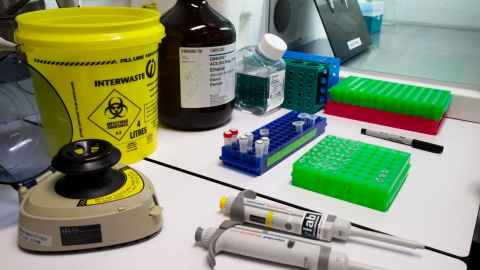Frequently asked questions
Here you'll find answers to common questions about chemical safety at the University.

If your question is not on this page and you think it should be, please email your request to the Health, Safety and Wellbeing team.
In your email please state that your question:
- Is for the Hazards and Containment Manager
- Should be added to this page.
Email now: hsw@auckland.ac.nz
How do I dispose of empty solvent winchesters?
If the winchesters contained a water miscible solvent (can mix without separating) such as ethanol, methanol or acetonitrile, rinse the Winchesters out thoroughly with water.
If the solvent is not water miscible (doesn’t mix together well and separates), evaporate the remaining traces of solvent out in a fume hood for at least 24 hours.
Completely deface the label, discard the top and place the clean winchesters in glass rubbish.
How do I dispose of surplus solvents?
Non-chlorinated solvents are refined and some fractions are recycled as printer’s ink solvent.
Chlorinated solvents are not so easily recycled and so must be sent overseas for treatment. This means that chlorinated solvents cost more than six times the cost of non-chlorinated solvents to dispose.
Therefore, it is vitally important that chlorinated solvent is kept separate from non-chlorinated solvent.
To arrange disposal, contact your local Technical Manager or the Hazards and Containment Manager.
I found some old chemicals in a clean-up. What should I do with these?
Contact your local Technical Manager. Request a visit and help to arrange disposal. If there are old bottles of ether or picric acid, do not move the containers under any circumstances. Contact the Hazards and Containment Manager urgently.
Email the manager now: hsw@auckland.ac.nz
What medical waste can go in the yellow bags and what can go in the sharps bins?
- All contaminated and/or broken lab glass, needles and syringes and hard plastic pipettes go in sharps bins.
- Only petri dishes, gloves, tissues, tissue culture flasks and pipette
tips go in the bags. - Please ensure the lids on sharps bins are firmly snapped onto the bin.
Remember: Any material that has come in contact with GMOs, high-titre viral vector stock or with pathogenic bacteria must be autoclaved or chemically decontaminated prior to disposal as medical waste.
Using a sharps bin as a bucket: The disposal cost is prepaid, therefore medical waste sharps bins are very expensive buckets for cleaning up.
I want to use formalin for preserving tissue. What precautions do I need to observe?
Formaldehyde and formaldehyde containing solutions such as formalin are toxic. It is a known chemical sensitiser and is also a probable carcinogen.
The Working Exposure Standard (WES) for formaldehyde is 1 ppm which must never be exceeded. The olfactory threshold for formaldehyde is 0.8 ppm for most persons.
Important: If you can smell formaldehyde it is likely you have exceeded the legal limit.
- Always handle formaldehyde in a fume cupboard (to reduce nasopharangeal and respiratory exposure) and wear nitrile gloves to reduce skin exposure.
- Consider substituting formaldehyde with ethanol as a fixing agent wherever possible.
The testing certificate on the fume hood I am using is expired. Who do I contact?
Contact your Technical Manager immediately to arrange for the fume hood to be tested.
Document Control
Version: 1.0
Last Updated: Dec 2019
Next Review: Dec 2022
Owner: hsw@auckland.ac.nz
Approver: Associate Director, Health Safety & Wellbeing